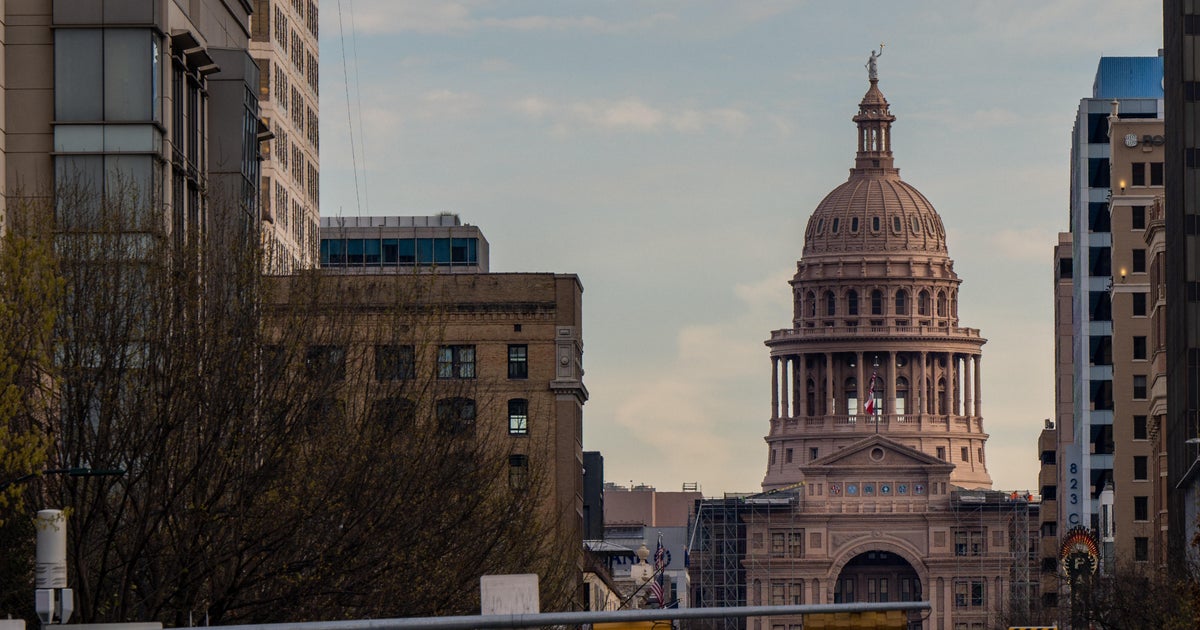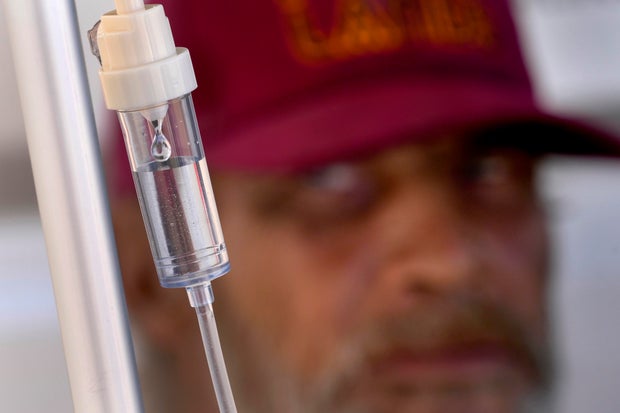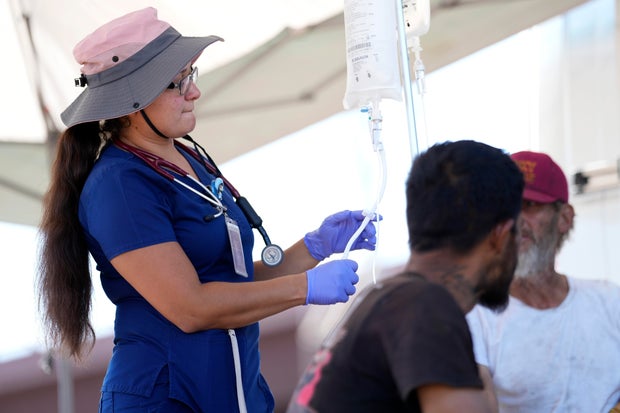CBS News
Riley Gaines among more than a dozen college athletes suing NCAA over transgender policies

Former Kentucky swimmer Riley Gaines was among more than a dozen college athletes who filed a lawsuit against the NCAA on Thursday, accusing it of violating their Title IX rights by allowing transgender woman Lia Thomas to compete at the national championships in 2022.
The lawsuit, filed in U.S. District Court in Atlanta, details the shock Gaines and other swimmers felt when they learned they would have to share a locker room with Thomas at the championships in Atlanta. It documents a number of races they swam in with Thomas, including the 200-yard final in which Thomas and Gaines tied for fifth but Thomas, not Gaines, was handed the fifth-place trophy.
Thomas swam for Pennsylvania. She competed for the men’s team at Penn before her gender transition.
Another plaintiff, Tylor Mathieu of Florida, finished ninth in the preliminary heats of the 500 free, which left her one spot from swimming in the final that Thomas would go on to win. Thomas was the first openly transgender athlete to win a Division I title in any sport, finishing in front of three Olympic medalists for the championship. By not making the final, Mathieu was denied first-team All-American honors in that event.
Darren Abate / AP
Other plaintiffs included athletes from volleyball and track.
The lawsuit said the plaintiffs “bring this case to secure for future generations of women the promise of Title IX that is being denied them and other college women” by the NCAA.
“College sports are the premier stage for women’s sports in America, and while the NCAA does not comment on pending litigation, the Association and its members will continue to promote Title IX, make unprecedented investments in women’s sports and ensure fair competition in all NCAA championships,” the NCAA said in a statement.
Critics contend s have an advantage over cisgender women in competition, though extensive research is still generally lacking on elite athletics and virtually nonexistent when it comes to determining whether, for instance, a sophomore transgender girl has a clear advantage over her cisgender opponents or teammates.
In 2022, the NCAA followed the lead of the U.S. Olympic and Paralympic Committee and revised its policies on transgender athlete participation to attempt to align with national sports governing bodies.
The third phase of the revised policy adds national and international sports governing body standards to the NCAA’s rules and is scheduled to be implemented for the 2024-25 school year.
The lawsuit also lists the University of Georgia system as a defendant because one of its schools, Georgia Tech, hosted the 2022 championships. The suit seeks to halt the NCAA from employing its transgender eligibility policies “which adversely impact female athletes in violation of Title IX” at upcoming events being held in Georgia.
Representatives from the Georgia schools said they had not been served with the lawsuit and would not comment.
CBS News
Meet the designer turning classic Venetian glass into modern art

Watch CBS News
Be the first to know
Get browser notifications for breaking news, live events, and exclusive reporting.
CBS News
Minnesota Vikings rookie Khyree Jackson dies in car accident

MINNEAPOLIS — Minnesota Vikings rookie Khyree Jackson died overnight in a car accident.
The Upper Marlboro, Maryland native played for Alabama and Oregon. He was drafted by the Vikings in April in round 4 as the 108th overall pick.
He was 24 years old.
“Our thoughts are with Khyree’s family, friends, teammates and coaches, as well as all the victims of this tragic accident,” the Vikings wrote on X.
Vikings head coach Kevin O’Connell said he was “crushed” by the news of Jackson’s death.
“In our short time together, it was evident Khyree was going to develop into a tremendous professional football player, but what was more impressive was his desire to become the best person he could be for his family and those around him,” O’Connell added.
The crash happened in Upper Marlboro shortly after 3 a.m. and involved three cars, according to Maryland state police. Investigators believe the driver of a silver Infiniti car tried to change lanes at a high rate of speed and struck the car that Jackson was in, as well as a Chevrolet Impala.
The two other occupants of Jackson’s car also died in the crash. The occupants of the other cars were not hurt.
Officials believe that alcohol could have been a contributing factor in the crash.
In a statement, the Minnesota Vikings say they have offered support to Jackson’s family, and are offering counseling and emotional support to the players who seek it.
This is a developing story. Check back with WCCO.com for more.
Note: The above video first aired on June 24, 2024.
CBS News
Street medics treat heat illnesses among homeless people as temperatures rise

Alfred Handley leaned back in his wheelchair alongside a major Phoenix freeway as a street medicine team helped him get rehydrated with an intravenous saline solution dripping from a bag hanging on a pole.
Cars whooshed by under the blazing 96-degree morning sun as the 59-year-old homeless man with a nearly toothless smile got the help he needed through a new program run by the nonprofit Circle the City.
“It’s a lot better than going to the hospital,” Handley said of the team that provides health care to homeless people. He’s been treated poorly at traditional clinics and hospitals, he said, more than six years after being struck by a car while he sat on a wall, leaving him in a wheelchair.
Circle the City, a non-profit that works in multiple cities and hospitals and treats about 9,000 people annually, introduced its IV rehydration program as a way to protect homeless people in Phoenix from life-threatening heat illness as temperatures regularly hit the triple-digits in America’s hottest metro.
Matt York / AP
Homeless people accounted for nearly half of the record 645 heat-related deaths last year in Maricopa County, which encompasses metro Phoenix. As summers grow warmer, health providers from San Diego to New York are being challenged to better protect homeless patients.
Dr. Liz Frye, vice chair of the Street Medicine Institute which provides training to hundreds of healthcare teams worldwide, said she didn’t know of groups other than Circle the City administering IVs on the street. The organization also distributes tens of thousands of water bottles each summer and tries to educate people about hot weather dangers.
“But if that’s what needs to happen to keep somebody from dying, I’m all about it,” Frye said.
Bringing care to people in need
The amount of people requiring treatment for heat illnesses is rising. The Boston Health Care for the Homeless Program, featured in last year’s book, “Rough Sleepers,” now sees patients with mild heat exhaustion in the summer after decades of treating people with frostbite and hypothermia during the winter, said Dr. Dave Munson, the street team’s medical director.
“It’s certainly something to worry about,” said Munson, noting that temperatures in Boston hit 100 degrees with 70% humidity during June’s heat wave. Homeless people, he said, are vulnerable to very hot and very cold weather not only because they live outside, but they often can’t regulate body temperature due to medication for mental illness or high blood pressure, or because of street substance use.
The Phoenix team searches for patients in homeless encampments in dry riverbeds, sweltering alleys and along the canals that bring water to the Phoenix area. About 15% are dehydrated enough for a saline drip.
Matt York / AP
“We go out every day and find them,” said nurse practitioner Perla Puebla. “We do their wound care, medication refills for diabetes, antibiotics, high blood pressure.”
Puebla’s street team ran across Handley and 36-year-old Phoenix native Phillip Enriquez near an overpass in an area frequented by homeless people because it’s near a facility offering free meals. Across the road was an encampment of tents and lean-tos along a chain-link fence.
Enriquez sat on a patch of dirt as Puebla started a drip for him. She also gave him a prescription for antibiotics and a referral to a dentist for his dental infection.
Living outside in Arizona’s broiling sun is hard, especially for people who may be mentally ill or use sedating drugs like fentanyl that make them less aware of their surroundings. Stimulants like methamphetamine contribute to dehydration, which can be fatal. Dr. Matt Essary, who works with Circle in the City’s mobile clinics, said the organization also often treats surface burns that can happen when a medical emergency or intoxication causes someone to fall on a sizzling sidewalk.
Matt York / AP
Temperatures this year have reached 115 degrees in metro Phoenix, where six heat-related deaths have been confirmed through June 22. Another 111 are under investigation, and the city is seeing an “increasing” number of patients with heat illnesses every year, according to Dr. Aneesh Narang, the assistant medical director of emergency medicine at Banner Medical Center-Phoenix, which treats many homeless people with heat stroke.
Narang’s staff works frequently with Circle the City, whose core mission is providing respite care, with 100 beds for homeless people not well enough to return to the streets after a hospital stay.
Extreme heat worldwide requires a dramatic response, said physician assistant Lindsay Fox, who cares for homeless people in Albuquerque, New Mexico, through an initiative run by the University of New Mexico’s School of Medicine.
Three times weekly, Fox treats infections, cleans wounds and manages chronic conditions in consultation with hospital colleagues. She said the prospect of more heat illness worries her.
Highs in Albuquerque can hit the 90s and don’t fall enough for people living outside to cool off overnight, she said.
“If you’re in an urban area that’s primarily concrete, you’re retaining heat,” she said. “We’re seeing heat exposure that very quickly could go to heat stroke.”
Serious heat stroke is far more common in metro Phoenix, where Circle the City is now among scores of health programs for the homeless in cities like New York, San Diego and Spokane, Washington.
Circle the City works with medical staff in seven Phoenix hospitals to help homeless patients get after-care when they no longer need hospitalization. It also staffs two outpatient clinics for follow-up.
Rachel Belgrade waited outside Circle the City’s retrofitted truck with her black-and-white puppy, Bo, for Essary to write a prescription for the blood pressure medicine she lost when a man stole her bicycle. She accepted two bottles of water to cool off as the morning heat rose.
“They make all of this easier,” said Belgrade, a Native American from the Gila River tribe. “They don’t give you a hard time.”












